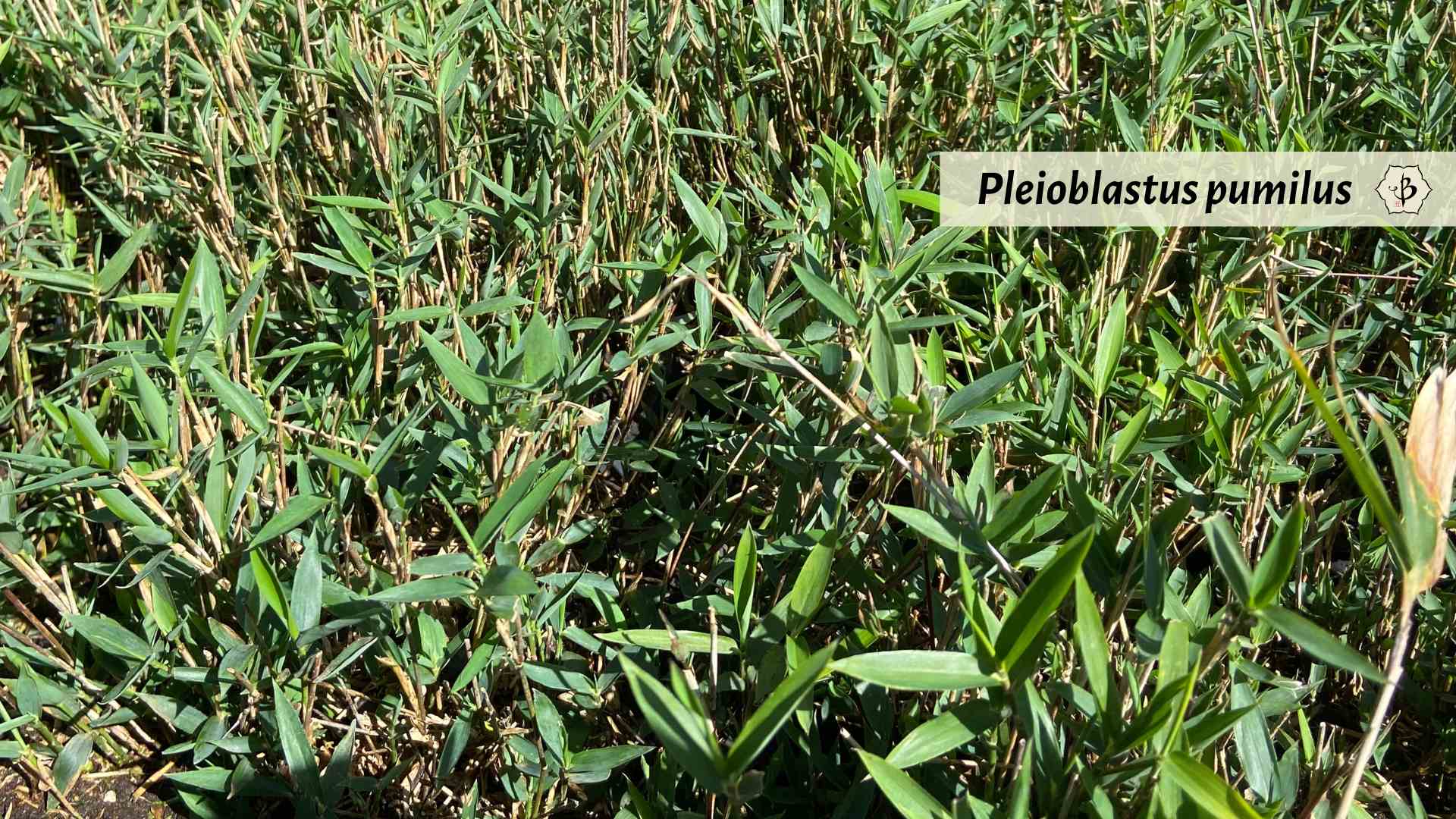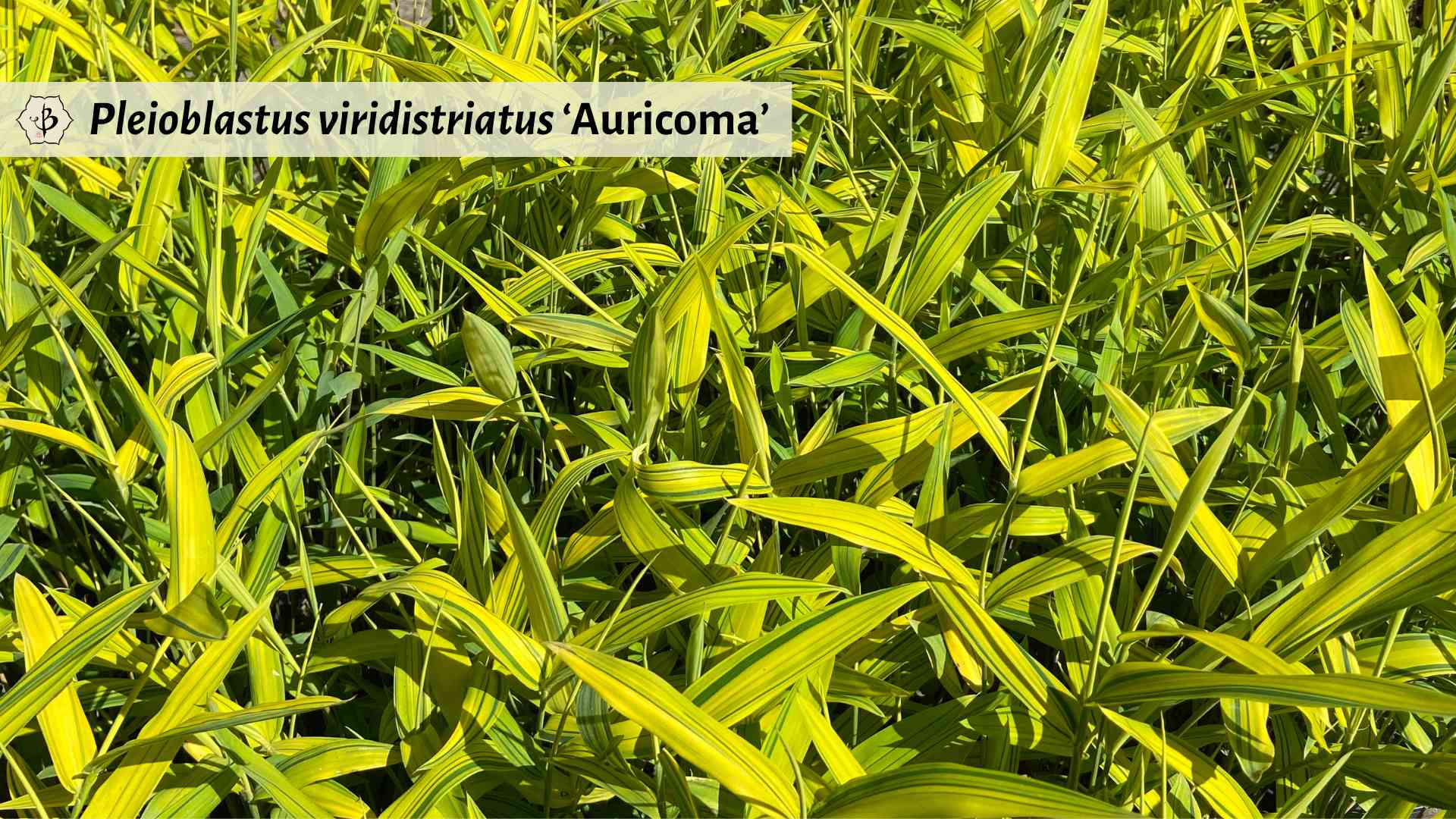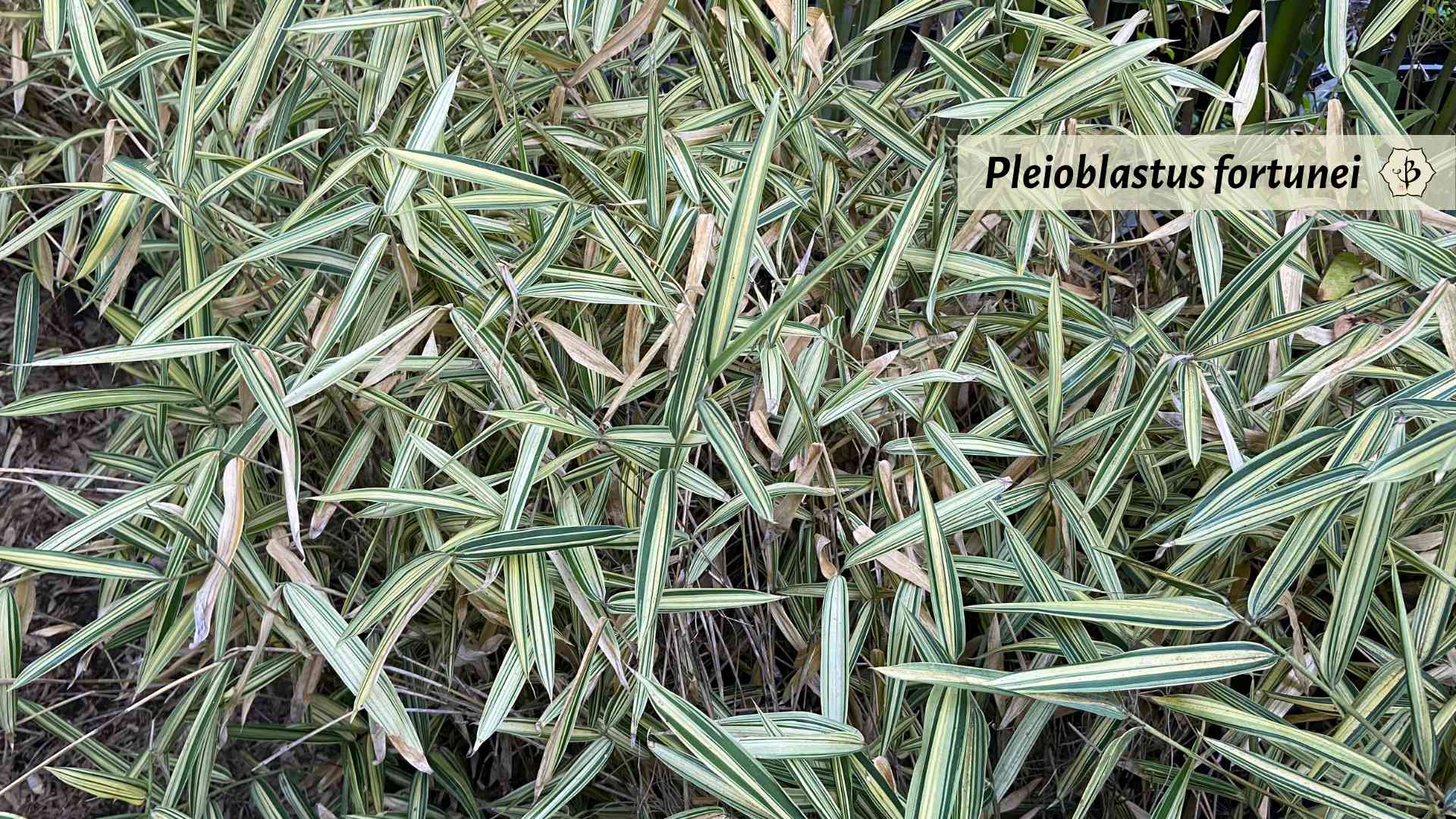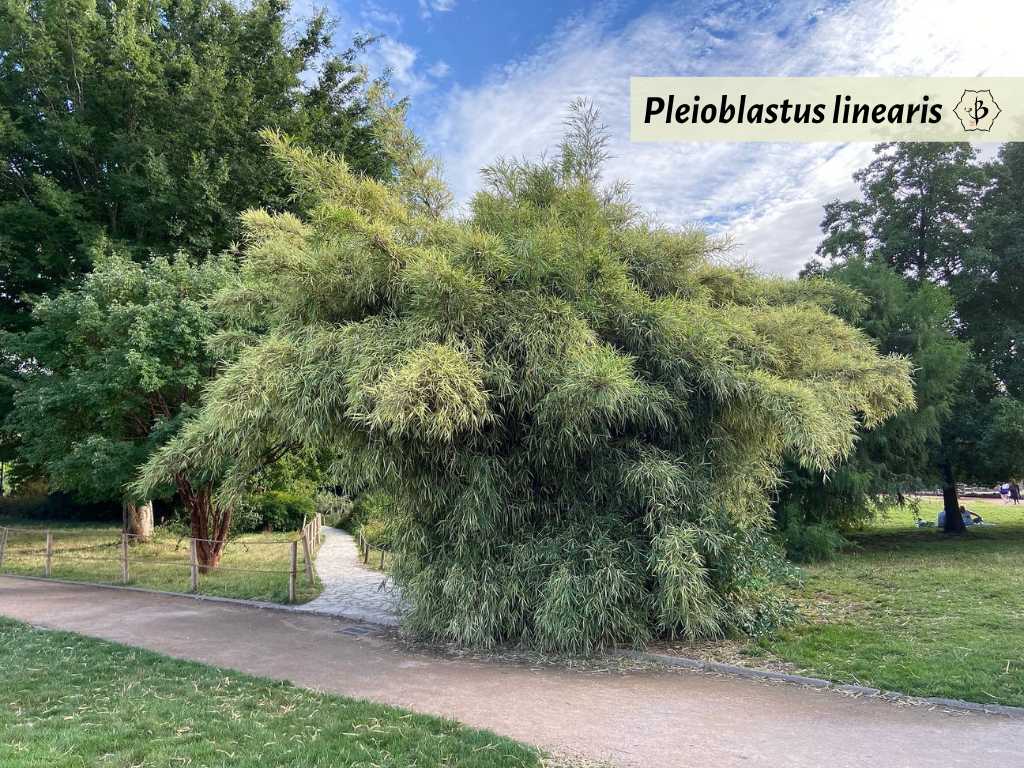Close your eyes to imagine a grove of bamboo, and you’ll probably picture something majestic. Long, elegant poles extend skyward, towering overhead, knocking together in the breeze. A soft rustling of leaves accompanies the percussion of hollow canes, as you are lulled into a state of profound tranquility. It can be a glorious thing indeed. But did you know, there are also a wide variety of bamboo species that grow no more than a couple feet tall? Well, it turns out, size isn’t everything.
Pleioblastus is a genus of running bamboo native to East Asia but naturalized throughout the world, and it includes roughly two dozen species. Unlike some of their better-known and more colossal cousins, many varieties of Pleioblastus will only get to be 2 or 3 feet tall, with culms thinner than your little pinkie finger. Most of these species are hardy to about 0º to 10º F.
Perhaps not as impressive as the grand specimens of timber bamboo, these dwarf bamboos can add great interest to a garden. Their diminutive size and abundant leaves make them ideal as ground covers, or accents alongside larger plants and trees. And their unusually striped leaves will bring an extra dimension of beauty to your greenery.
This article — first published in October 2020 and last updated in May 2024 — is part of an ongoing series about different types and species of bamboo. To learn more about this fascinating and diverse collective, be sure to check out these other articles.
- Running bamboo
- Genus Phyllostachys: Prolific bamboo for all climates
- Genus Chimonobambusa: Exotic Asian bamboo
- Clumping bamboo
- Genus Chusquea: Solid bamboo of the Americas
- Genus Fargesia: Clumping bamboo for cold climates
- Native bamboos of North America: Arundinaria
- Herbaceous bamboo: Olyreae
Characteristics of Pleioblastus
Bamboos of the genus Pleioblastus are native to East Asia, primarily China and Japan. As opposed to tropical varieties from further south, Pleioblastus species are quite cold-tolerant. And like most cold-hardy bamboo, they have running rhizomes. Most species of Pleioblastus are small, dwarf varieties of bamboo, which are very well suited as accents and ground covers. Some of the more popular cultivars also have variegated leaves, making them especially attractive in any garden.

Containing Pleioblastus
Most types of Pleioblastus are quite small, looking more like shrubs or ground covers, rather than trees. Typically we call these dwarf bamboos. But don’t be fooled. Despite their small size, these plants can spread very vigorously and even become invasive. Like other running bamboos, with monopodial, leptomorph rhizomes, the roots can extend quickly and in all directions. And though they are only an inch or two under the ground, they can go undetected for quite some time, until suddenly you have bamboo shoots coming up everywhere.
At the same time, their small size makes them much easier to contain than larger runners, like Phyllostachys, for example. If you see it getting out of control, it’s relatively easy to go in with a shovel and dig out the aggressive roots. But it’s difficult to be thorough. Running bamboo can be sneaky.
It will take some preparation and vigilance to keep these little runners in place. The best way to contain a running bamboo is to plant a root barrier around the area where you want it to grow. Bamboo shield is an excellent product available from Amazon. The heavy-duty plastic barrier comes in a few sizes, and goes in the ground up to 2 feet deep, which is more than adequate for a dwarf bamboo.
Another simple solution is to dig a trench around the bamboo. This will deter the running rhizomes and make them easier to detect as they try to expand their footprint. For smaller bamboos like Pleioblastus, a one-foot trench should be sufficient. Many gardeners prefer to keep their bamboo in containers. For these petite varieties, something wide and shallow is probably best. They also look great in long, narrow planter boxers.

Propagating Pleioblastus
While the running roots make certain bamboos difficult to contain, they also make them very easy to propagate. When the soil is moist, you can dig out and detach a single culm or a small clump of culms from the plant. Just be very careful to keep as much of their roots intact as possible, when you separate them from the larger network of roots and rhizomes.
Place the intact division into its own separate pot with some rich, moist, well-drained soil. Bamboo likes a lot of nitrogen, and I like to fertilize with organic compost or manure. Bamboo also likes to stay moist, especially when it’s transplanted. But good drainage is key. Bamboo cannot tolerate saturated or soggy soil.
Check out our in-depth articles on Propagating bamboo, Fertilizing bamboo and Watering bamboo.
Pruning Pleioblastus
Containing the roots will be the most important job in maintaining a dwarf, running bamboo. But you might also want to cut it back. Either manually or with a power trimmer, you can keep dwarf bamboos short, similar to how you’d mow your lawn. It is a grass after all, and regular pruning will promote the growth of more fresh leaves. It can also give a nice, well-manicured appearance.
If you live in a cold climate with freezing winters, Pleioblastus are a good choice, mostly hardy down to about 0º F. But the leaves are likely to brown and die back in the winter. You can prune them back when this happens, or you can wait. By giving the plant a thorough pruning toward the end of winter, this will prime the plant to produce a fresh wave of foliage in the spring.
Since the stems or culms of these varieties are so thin, you don’t usually have to go in and remove old, woody canes, or prune the culms and branches separately. A decent set of hedge clippers or power trimmers should work just fine around the whole plant.
Growing conditions
Because dwarf bamboos naturally grow in the shade of the forest canopy, they will almost always prefer a shady spot in your garden. This should be easy enough to do if you are planting it as an accent to larger trees and bamboos. If you have a small garden that just doesn’t get much sunlight, Pleioblastus is definitely a good option to consider.
I got stripes
In addition to their short stature, making them perfect as ground covers or accents, in a Japanese garden setting, for example, many kinds of Pleioblastus also have distinctive stripes on their leaves. You can find an assortment of stripes, or variegations, including, green and white, green and yellow, or different shades of green. These striped cultivars tend to be the most popular, as they really add a splendid visual effect to the garden.

Species of Pleioblastus
The genus Pleioblastus comprises about 24 species of bamboo, making it one of the smaller genera in this subfamily of grasses. But some of these species have multiple cultivars, which significantly increases the total number of Pleioblastus varieties. There is also less than perfect agreement on the classification of some species, making it pretty difficult to come up with an exact number.
Several of these varieties are widely available and fairly popular in North America, at least among bamboo enthusiasts. But others remain quite rare, yet highly desirable among collectors.
Pleioblastus akebono: A height of 12-18 inches makes this one of the smallest bamboos of all. Fresh leaves come up almost white, slowly developing variegation and turning also solid, dark green. A beautiful specimen for shady spots and cooler climates.
Pleioblastus chino ‘Murakamianus’: Chino is an uncommon species, and not one that every botanist recognizes. But this variegated form has beautifully striped leaves, green and white, that make it a very attractive specimen. Without pruning, it can get 5 or 6 feet tall. It can also be kept as a ground cover, pruned to about 2 feet tall. Cold hardy to around 0 F.
Pleioblastus distichus: Also classified as Sasa disticha or Pseudosasa disticha, and sometimes referred to as Dwarf Fernleaf bamboo, for the tight clusters of leaves that look a bit like fern fronds. A true dwarf, this species only gets about 2 feet tall.
Pleioblastus distichus ‘Mini’: If we had to name the smallest bamboo of all, this might very well be it. The remarkable cultivar only gets 6 to 12 inches tall. Leaves are solid dark green and bushy, and they prefer a lot of shade. Very popular as an accent plant for Japanese gardens.
Pleioblastus distichus ‘Akebono’: A miniature bamboo with interesting green and white stripes, growing just one foot tall. A bit confusing, some nurseries consider it the same as P. akebono, while other make a distinction.
Pleioblastus distichus ‘Green Carpet’: No different than the standard P. distichus, Green Carpet is simply a trademark name used by a company called BambooSelect. The trademark expired many years ago, but the name is still in circulation. Yet another example of the kind of nomenclature confusion we often encounter in the world of bamboo.

Pleioblastus fortunei: One of the most popular species of this genus, commonly known as Dwarf White-stripe. Great as a short hedge or a ground cover, growing about 2 to 3 feet tall, with bright green leaves with attractive white stripes.
Pleioblastus pygmaeus: Commonly known as Pygmy bamboo, this is another popular dwarf species, with solid, bright green leaves. It generally grows up to about 2 feet high, but can be pruned much shorter. Small hairs are detectable on the leaves. Ideal candidate for bonsai.
Pleioblastus gramineus: A taller member of the genus, gramineus grows 10 or 15 feet tall with thick foliage that makes an effective privacy screen.
Pleioblastus linearis: Similar in size and features to gramineus, this taller bamboo has thin, delicate culms and slightly longer leaves. Another good choice for a cold-hardy privacy screen. (See image below.)

Pleioblastus pumilus: Formerly listed as Arundinaria pumila, this dwarf bamboo has vibrant green leaves and forms a low hedge about 2 to 3 feet tall. (See image above.)
Pleioblastus solidus: A larger species, this one can get 10 or 15 feet tall. Still, the culms are only about half an inch thick. Not quite solid as the name suggests, but nearly, with thick culm walls. Native to eastern China, this species has not really come to North America yet.
Pleioblastus variegatus: Another species known as Dwarf White-stripe, and not always recognized as distinct from P. fortunei. Grows about 2 to 3 feet tall, with bright green leaves with attractive white stripes. Some nurseries identify a subspecies, P. variegatus ‘Tsuboli’, with very similar traits.
Pleioblastus viridistriatus: Commonly known as Dwarf Green-stripe, this is another eye-catching species well suited as a hedge or ground cover. Grows 2 to 4 feet tall, with variegated leaves, dark and light green, or green and yellow. One of the most cold-hardy members of the genus, it can survive winters of -10º F.

Further reading
If you’d like to learn more about growing and using bamboo, take a look at some of our most popular articles.
- Growing Bamboo: The complete how-to guide
- Best bamboo varieties for your garden
- Watering your bamboo
- Fertilizing your bamboo
- Pruning your bamboo
- Bamboo anatomy: 9 parts of the bamboo plant
FEATURED PHOTO: A collection of Pleioblastus species. Photos by Fred Hornaday.

























